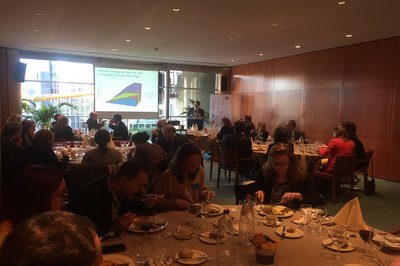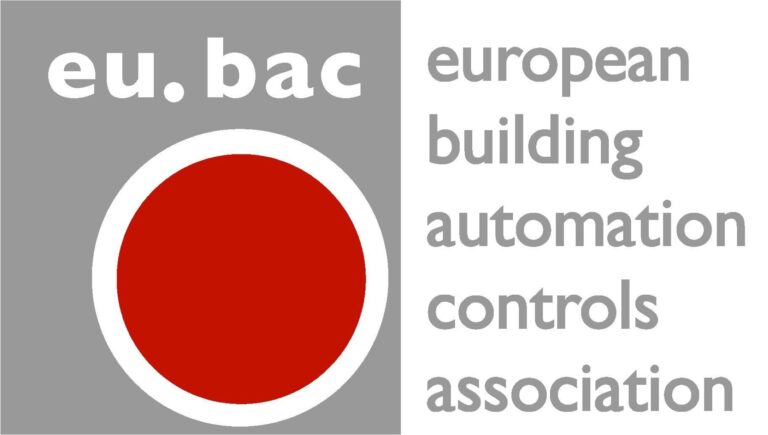eu.bac Lunch Debate “The multiplier effect of Building Automation and Controls: How to maximize energy savings throughout the whole lifecycle”

On 28 November 2016, eu.bac, together with MEP Theresa Griffin, organised a lunch debate on “The multiplier effect of Building Automation and Controls: How to maximize energy savings throughout the whole lifecycle”.
The event, which followed the one focused on the behavioural aspect held in September, took place in one of the Members’ Salon in the European Parliament and was attended by representatives of the institutions, industry associations, consultancies and scientific coomunity.
The discussion, led by moderator Dr. Peter Hug, Managing Director eu.bac, started with an introduction by the co-host, MEP Ms. Theresa GRIFFIN, Member of the Committee on Industry, Research and Energy (ITRE). She emphasized the importance of the incoming Winter Package and the need to have ambitious policies, finally able to achieve energy efficiency and to support households at risk of energy poverty. Furthermore, she added other fundamental goals to be met: less emission, energy security, improving health conditions and decreasing energy bills. Listing these goals, Ms. Griffin reminded the participants that the European Parliament called for a 40% binding target for energy efficiency, without forgetting to strive to unlock investments.
Building automation and controls can play a key role for achieving all these goals, thus policies should be designed accordingly.
Mr. Vasco Ferreira, DG ENER, Buildings Team Acting Leader, provided an overview of the European policies on Energy efficiency, at first highlighting the importance of Ecodesign measures as cornerstone of the EU’s sustainable industrial policy, moving then to the new reform of the Energy Performance of Buildings Directive (EPBD), started in 2014 with public consultations and targeted workshops. The new EPBD, which is part of the “Clean Energy package“, will bring and promote the use of ICT in buildings. Building automation and controls have a key role in this framework: through their proven ability to continuously control and benchmark buildings, they can efficiently substitute inspections of the heating and air conditioning systems, detecting malfunctionalities and reacting accordingly.
Building Automation and Control systems will also be included in the list of products subject to the preparatory studies for the new Ecodesign Working Plan 2016-2019, that will investigate in detail their potential for environmental improvement, leading eventually to future changes in the EPBD. Another relevant innovation proposed by the Commission is the “smartness indicator“, rating the readiness of the building to adapt its operation to the needs of the occupant and of the grid, to improve its performance. He reassured the participants about the fact that this will not be another additional indicator but it will be linked to the EPC: the purpose is making the people who buy or rent a building aware of other important information regarding the energy performance of that building, so far not adequately included in the EPC. This will be, concluded Mr. Ferreira, another important instrument to further realize the potential of Building Automation and Controls.
Mr. Paul Waide, Director Waide Strategic Efficiency, started his presentation right where Mr. Ferreira’s concluded his speech: how to realize the full potential of BACs and overcome the exisiting barriers. He listed some of the benefits of BACs, from the resulting high quality indoor conditions, to the optimizing functions, impacting on the final performance of all building systems and reducing energy consumption and running costs.
He continued showing the participants some very interesting figures, demonstrating that BACs can bring savings up to 9% of all EU energy consumption (22% of building energy consumption), with over 200 Mtoe of energy savings and emission reductions up to 5.9 Gt CO2. All of this with estimated investments of €136 billion in order to save €1200 billion operating costs by 2035.
This is not happening, claimed Mr. Waide, due to some generic barriers such as limited know-how on implementing energy-savings measures, split incentives and energy efficiency still not visible to end users and service procurers. Mr. Waide called for an increase of demand and deployment, as well as reliability of savings and, from a policy perspective, strengthening EPBD Article 8 to ensure that BACs have a suitable functionality.
Mr. Yann Mahieu, Director Key Account Solutions, Johnson Controls, started his presentation on the multiplier effect of BACs in non-residential buildings explaining how EU has now the opportunity, through the review of its policies, to lead the way to Buildings 4.0, accelerating the adoption of IoT and energy management smart functions through the extension of BACs to smaller non-residential buildings. He continued his dissertation on the importance of Controls Loop Commissioning, improving space comfort and boosting savings, then going through BAC equipment energy optimizations, showing examples of lighting and shade management, as well as predictive start stop related to environmental and occupancy conditions. Most advanced building automation controls and systems are also offering smart control functions, supporting the optimized local usage of renewables and the storage of energy. Concluding, he revealed some data concerning the energy savings that can be achieved in a standard office building thanks to BACs: +5% Equipment organization, +7% Controls Loop Commissioning, +6% Life Cycle Management, +4% Building optimization, +2% Energy Awareness, with all of these that can be multiplied through new technologies and IoT equipment extension.
Last but not least, Ms. Constanze Picking, Director Government Relations Honeywell EMEA, walked the attendants through a residential example of the multipliereffect of BACs, underlining how the ongoing EPBD review offers a unique opportunity to trigger substantial benefits for tenants and owner of residential buildings. This should happen through some essential actions: improvement of the efficiency of the installed base, creation of energy awareness at end user level, acceleration of old heating replacement and more connectivity, leading to an added value for the end user. Ms. Picking reported that 70 million homes in Europe are still equipped with manual radiator valves. An upgrade with basic technology would bring EU annual savings of 160 TWh, save 29 million tons of CO2 and cut European citizens’ bills by nearly €12 billion. The payback period is estimated in 2 years, with a 700% of returns from the investments.After having shown figures clearly reflecting how the benefits and savings of other technical building systems can be multiplied thanks to BACs (i.e. +8/12% hydraulic balancing), she concluded stressing the importance of creating energy awareness at end user level through best practices (i.e. German labelling) and encouraging the use of smart thermostats link to smart devices.
Dr. Peter Hug concluded the event thanking attendees for their presence and participation, with the hope to see soon a new legislation able to remove the market barriers preventing the realization of BACs potentials and, doing so, driving manufacturers’ investments into R&D and innovation, empowering consumers, enhance their health, boost their savings, alleviate energy poverty, reducing gas imports and greenhouse gas emissions.
